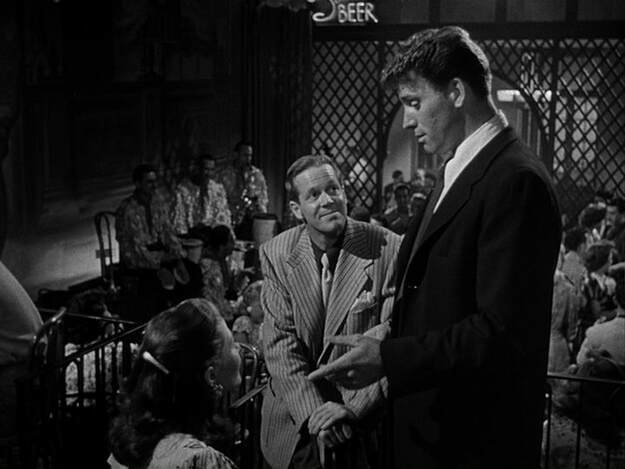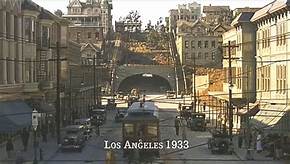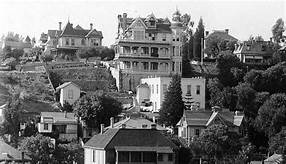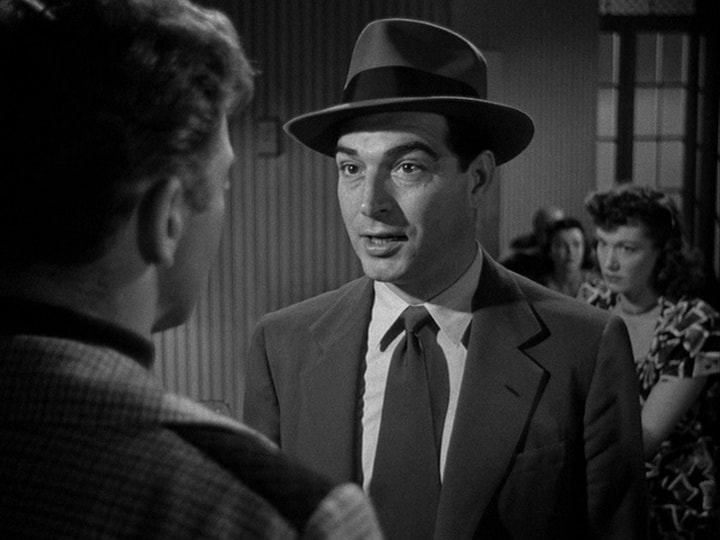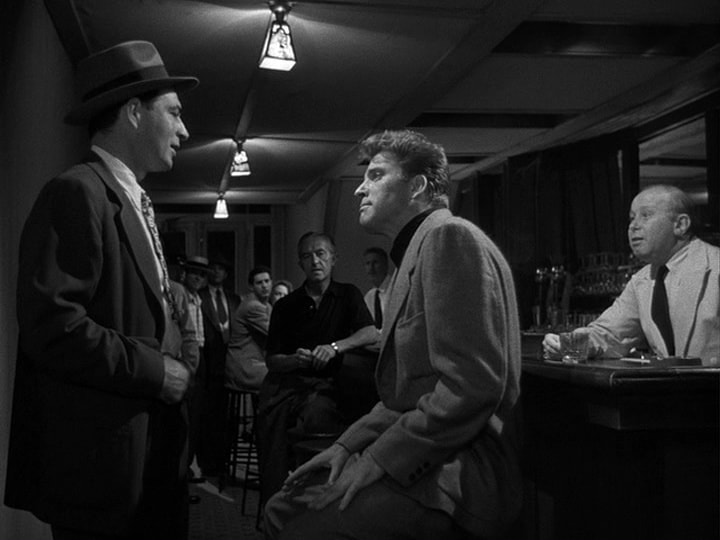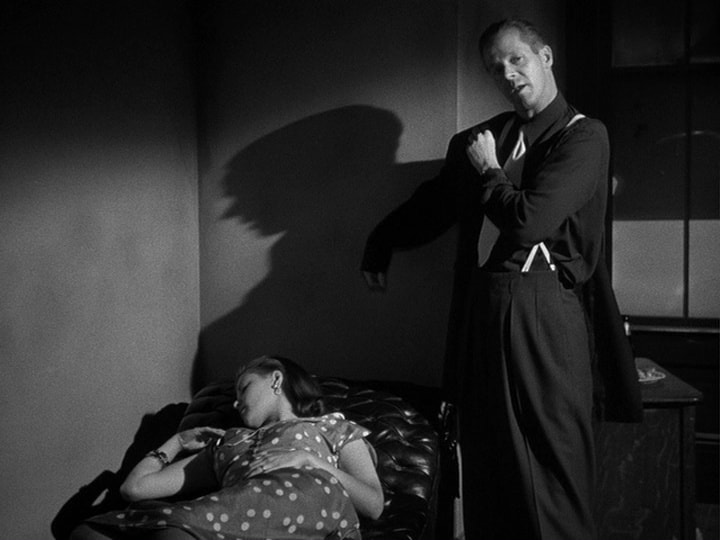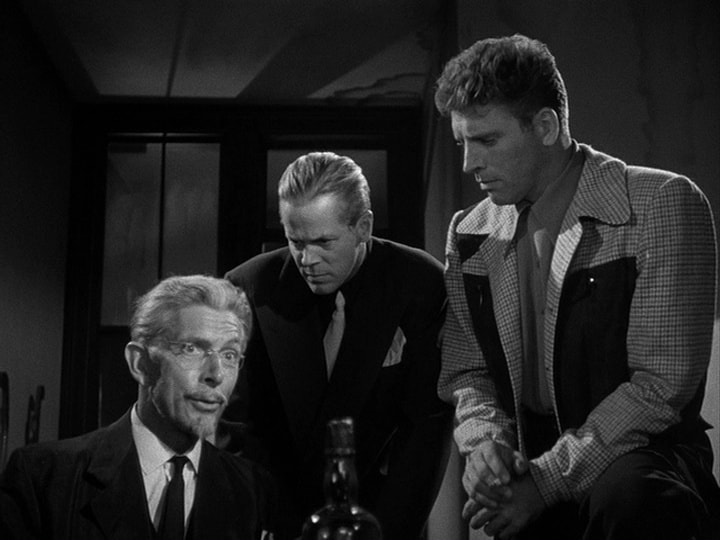#13 CRISS CROSS
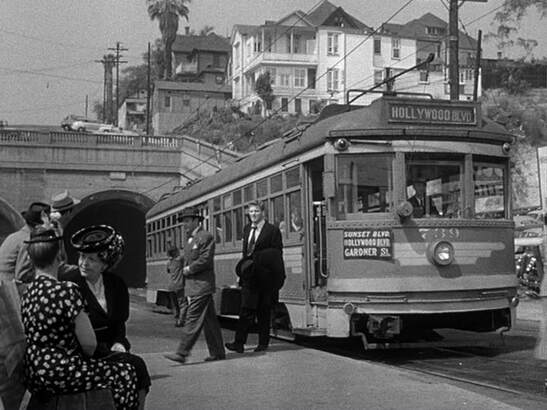
Steve Thompson (Burt Lancaster) should have listened to Thomas Wolfe about going home again, but that’s not how it works in the world of noir. A staple of noir is running from, being burdened by, or needing to atone for a previous misstep done in the past. The Swede succinctly sums it up in The Killers, "I did something wrong once." Thompson is different. He optimistically, indeed cheerfully, returns to his home after years of being on the road.
He visits his old watering hole and asks the bartender (Percy Helton) where's the old crowd? Helton wants to know if he's talking about the old, old crowd that he once knew and where now middle aged men sit and drink at the bar or is it the new, old crowd where neighborhood 'yutes' dance and mingle? If Steve were smart he’d visit for a couple of days then leave for some other place. But he’s not that smart, in fact he’s not smart at all; he is not a bright boy. The reason for his return, although he denies it, is to reunite with his ex-wife , Anna (Yvonne DeCarlo), who happens to be the main squeeze of the local big shot hood, Slim Dundee (Dan Duryea.)
With few exceptions film noir is not played out on a grandiose stage of complexities and conspiracies. Its scope is local and parochial and Criss Cross is an excellent example. From the steep streets that lead to the neighborhood bar, kids playing in the streets, the film centers on a local group of small time hoods, who are the sort that would more than likely have lived their entire lives in the old neighborhood. In this film the old neighborhood is the Bunker Hill section of Los Angeles. Bunker Hill has been used as a backdrop for many movies. In Criss Cross it could have been another supporting character.
Bunker Hill has an interesting background and may be the precursor of urban gentrification. Raymond Chandler in High Window, pens this description: “Bunker Hill is old town, lost town, shabby town, crook town... Once, very long ago, it was the choice residential district of the city... They are all rooming houses now... In the tall rooms haggard landladies bicker with shifty tenants. On the wide cool front porches, reaching their cracked shoes into the sun, and staring at nothing, sit the old men with faces like lost battles."
And from Charles Bukowski: "I lived there too before they leveled off the poor and put up high-rises. It was the best place for the poor, the best place for cabbage and fish heads, boiled carrots, the old, the insane, the young who couldn't fit into the offices down there."
I don't think Siodmak adequately captured the desperation and grit of the neighborhood that Chandler and Bukowski described. Film noir is an evolution of the 'gangster' film of the 30s. Criss Cross, focuses on a particular urban working class neighborhood yet does little to fully develop its character and feel of its inhabitants. It would not have taken much. The apartment scenes of Cry Of The City, effectively portrays urban home life in Italian-American tenements. I do not see any of that in the film.
I'm not saying Criss Cross should have taken a socially conscious point of view like many from films of the 1930s, but it would have been nice to have been given a feel for, "the tall rooms ...with shifty tenants... and the old men with faces like lost battles." The core of film noir is based on cynicism, fatalism, and distrust toward authority, expressed primarily of the working class. That demographic is the essence of film noir and as important in classic film noir as German expressionism.
He visits his old watering hole and asks the bartender (Percy Helton) where's the old crowd? Helton wants to know if he's talking about the old, old crowd that he once knew and where now middle aged men sit and drink at the bar or is it the new, old crowd where neighborhood 'yutes' dance and mingle? If Steve were smart he’d visit for a couple of days then leave for some other place. But he’s not that smart, in fact he’s not smart at all; he is not a bright boy. The reason for his return, although he denies it, is to reunite with his ex-wife , Anna (Yvonne DeCarlo), who happens to be the main squeeze of the local big shot hood, Slim Dundee (Dan Duryea.)
With few exceptions film noir is not played out on a grandiose stage of complexities and conspiracies. Its scope is local and parochial and Criss Cross is an excellent example. From the steep streets that lead to the neighborhood bar, kids playing in the streets, the film centers on a local group of small time hoods, who are the sort that would more than likely have lived their entire lives in the old neighborhood. In this film the old neighborhood is the Bunker Hill section of Los Angeles. Bunker Hill has been used as a backdrop for many movies. In Criss Cross it could have been another supporting character.
Bunker Hill has an interesting background and may be the precursor of urban gentrification. Raymond Chandler in High Window, pens this description: “Bunker Hill is old town, lost town, shabby town, crook town... Once, very long ago, it was the choice residential district of the city... They are all rooming houses now... In the tall rooms haggard landladies bicker with shifty tenants. On the wide cool front porches, reaching their cracked shoes into the sun, and staring at nothing, sit the old men with faces like lost battles."
And from Charles Bukowski: "I lived there too before they leveled off the poor and put up high-rises. It was the best place for the poor, the best place for cabbage and fish heads, boiled carrots, the old, the insane, the young who couldn't fit into the offices down there."
I don't think Siodmak adequately captured the desperation and grit of the neighborhood that Chandler and Bukowski described. Film noir is an evolution of the 'gangster' film of the 30s. Criss Cross, focuses on a particular urban working class neighborhood yet does little to fully develop its character and feel of its inhabitants. It would not have taken much. The apartment scenes of Cry Of The City, effectively portrays urban home life in Italian-American tenements. I do not see any of that in the film.
I'm not saying Criss Cross should have taken a socially conscious point of view like many from films of the 1930s, but it would have been nice to have been given a feel for, "the tall rooms ...with shifty tenants... and the old men with faces like lost battles." The core of film noir is based on cynicism, fatalism, and distrust toward authority, expressed primarily of the working class. That demographic is the essence of film noir and as important in classic film noir as German expressionism.
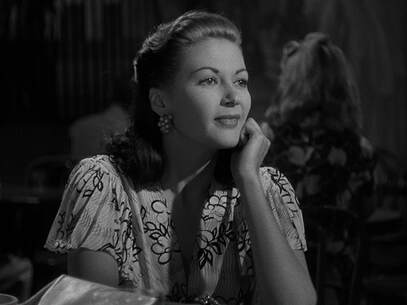
Similar to The Killers, the tale is told in flashback. The opening narrative begins the night before the heist. We see Thompson (Burt Lancaster) driving an armored car to the heist. Thompson narrates:
"From the start. The beginning. It all happened so fast.... I'd been all over the country.... Until finally I got her out of my system. ...I wasn't gonna go looking for her, I didn't expect to run into her. I didn't particularly want to see her. I was sure of that if I was sure of anything. But then...it all went one way. It was in the cards or it was fate... or a jinx or whatever you wanna call it."
There are similarities between this film and The Killers. Burt Lancaster reprises his role as the handsome, studly, but dumb as rocks noir chump who risks all for the gorgeous femme fatale who is married to the local bad guy crumb-bum. The femme fatale in this case is Yvonne DeCarlo. Dan Duryea's Slim Dundee takes the place of Colfax (Albert Dekker) and the concerned buddy from the same neighborhood who took the high road and became a cop, there is Stephen McNally (Lt. Rodriquez) in lieu of Sam Levene. I've a soft spot for noirs where a bit character actor makes an impression with a paucity of lines, in this film it's Tom Pedi. He is the most gung-ho of Dundee's group. He is not hesitant about going for broke and punctuates his enthusiasm with, "That's the ticket, that's the ticket." The incomparable Alan Napier is great as the brain, pickled or not, who plans the details for the heist.
Robert Siodmak's filmography in the forties is unmatched. I have seen eleven of his films from 1943-1950 and there is not a clunker among them. Prior to The Killers he directed Christmas Holiday with Deanna Durbin, The Suspect with Charles Laughton and Ella Raines, The Spiral Staircase with Dorothy McGuire, The Strange Affair of Uncle Harry with George Sanders and Ella Raines, and Phantom Lady again with Ella Raines. A All of the films have a cool, calm efficacy but Criss Cross could have used a little of the frenetic pacing we see in Raw Deal for example. Criss Cross is great served the way it is but for my taste it could have used a little bit of hot spice to enhance but not overwhelm a tasty dish.
Many of his leading ladies exhibit this calm efficacy particularly Raines, Durbin, McGuire and Fitzgerald. Yvonne DeCarlo should have been an exception. Her explosiveness and volatility are alluded to when she and Thompson talk about how they used to fight and, with a wink and nod, how they used to make up. We surmised that with Anna it's not if she's going to lose her temper but when and it happens near the end of the film. It would have been nice if a couple of times Siodmak had said, 'Yvonne, let's go full Sicilian in this scene.'
"From the start. The beginning. It all happened so fast.... I'd been all over the country.... Until finally I got her out of my system. ...I wasn't gonna go looking for her, I didn't expect to run into her. I didn't particularly want to see her. I was sure of that if I was sure of anything. But then...it all went one way. It was in the cards or it was fate... or a jinx or whatever you wanna call it."
There are similarities between this film and The Killers. Burt Lancaster reprises his role as the handsome, studly, but dumb as rocks noir chump who risks all for the gorgeous femme fatale who is married to the local bad guy crumb-bum. The femme fatale in this case is Yvonne DeCarlo. Dan Duryea's Slim Dundee takes the place of Colfax (Albert Dekker) and the concerned buddy from the same neighborhood who took the high road and became a cop, there is Stephen McNally (Lt. Rodriquez) in lieu of Sam Levene. I've a soft spot for noirs where a bit character actor makes an impression with a paucity of lines, in this film it's Tom Pedi. He is the most gung-ho of Dundee's group. He is not hesitant about going for broke and punctuates his enthusiasm with, "That's the ticket, that's the ticket." The incomparable Alan Napier is great as the brain, pickled or not, who plans the details for the heist.
Robert Siodmak's filmography in the forties is unmatched. I have seen eleven of his films from 1943-1950 and there is not a clunker among them. Prior to The Killers he directed Christmas Holiday with Deanna Durbin, The Suspect with Charles Laughton and Ella Raines, The Spiral Staircase with Dorothy McGuire, The Strange Affair of Uncle Harry with George Sanders and Ella Raines, and Phantom Lady again with Ella Raines. A All of the films have a cool, calm efficacy but Criss Cross could have used a little of the frenetic pacing we see in Raw Deal for example. Criss Cross is great served the way it is but for my taste it could have used a little bit of hot spice to enhance but not overwhelm a tasty dish.
Many of his leading ladies exhibit this calm efficacy particularly Raines, Durbin, McGuire and Fitzgerald. Yvonne DeCarlo should have been an exception. Her explosiveness and volatility are alluded to when she and Thompson talk about how they used to fight and, with a wink and nod, how they used to make up. We surmised that with Anna it's not if she's going to lose her temper but when and it happens near the end of the film. It would have been nice if a couple of times Siodmak had said, 'Yvonne, let's go full Sicilian in this scene.'
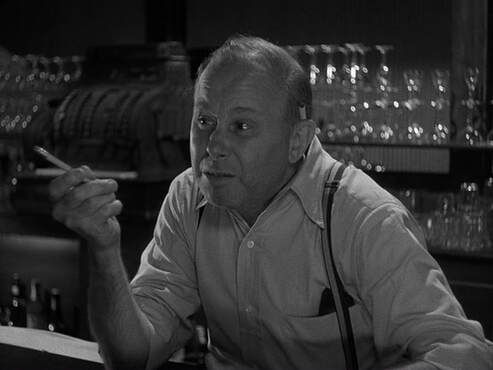
The contribution of supporting actors character actors, and bit role players is overlooked as a reason for classic noir's popularity. There is no finer example of that than the extremely talented Dan Duryea. He was never a major star but was one of the finest actors of the forties. If given a chance he could, and often did, steal any scene in a movie. Stephen McNally and Alan Napier are also in support, and as mentioned, Tom Pedi with his memorable catch phrase and the ubiquitous Percy Helton. The film is famous for introducing Tony Curtis, film buffs will recognize John Doucette, Vito Scotti, Gene Evans, and Robert Osterich.
A staple of film noir is a femme fatale and Anna fits the bill. Not long after Steve returns she forgets she's Slim's girl and goes to the beach with Steve. Steve is over the moon but she surprises him and marries Dundee. Slim goes away on business and almost quicker than it took to write this sentence does she begins where she left off with Steve and sleeps with him. She's in love with Steve yet loves Dundee's money and power. And Steve? He's as dumb as a rock when it comes to this woman.
Slim learns Steve and Anna have been playing patty-cake while he's been away. He confronts them at Steve’s house. Stuck between a rock and a hard place Steve explains she’s there only to hear his plan to rob an armored car. Slim is skeptical. He and his boys are used to penny ante stuff. He says everyone knows it's impossible to rob an armored car. Steve says he's got someone on the inside man. What Steve doesn't know is that his Pop will be taking over someone's shift and will be in the armored care. Anna is quiet, definitely looking which way the wind blows. When Steve mentions the robbery she sees a way to have money, to have Steve, to ditch Slim and skedaddle out of Bunker Hill.
You can pick out your own top 15 or top 20 noirs, and many, if not all will have a minor character who with a few scenes puts his mark on the film. I think of Ian Keith in, Nightmare Alley, Ian Wolfe in They Live By Night, Esther Howard in, Murder My Sweet, and Criss Cross has Alan Napier as Finchley. Finchley is an alcoholic, a step away from being a stumble bum. He's respected by Dundee and his crew for being the best in his line. They pay his liquor bill, show him a bottle of top shelf Scotch and he's all set. The planning stretches throughout the night and into the morning.
A staple of film noir is a femme fatale and Anna fits the bill. Not long after Steve returns she forgets she's Slim's girl and goes to the beach with Steve. Steve is over the moon but she surprises him and marries Dundee. Slim goes away on business and almost quicker than it took to write this sentence does she begins where she left off with Steve and sleeps with him. She's in love with Steve yet loves Dundee's money and power. And Steve? He's as dumb as a rock when it comes to this woman.
Slim learns Steve and Anna have been playing patty-cake while he's been away. He confronts them at Steve’s house. Stuck between a rock and a hard place Steve explains she’s there only to hear his plan to rob an armored car. Slim is skeptical. He and his boys are used to penny ante stuff. He says everyone knows it's impossible to rob an armored car. Steve says he's got someone on the inside man. What Steve doesn't know is that his Pop will be taking over someone's shift and will be in the armored care. Anna is quiet, definitely looking which way the wind blows. When Steve mentions the robbery she sees a way to have money, to have Steve, to ditch Slim and skedaddle out of Bunker Hill.
You can pick out your own top 15 or top 20 noirs, and many, if not all will have a minor character who with a few scenes puts his mark on the film. I think of Ian Keith in, Nightmare Alley, Ian Wolfe in They Live By Night, Esther Howard in, Murder My Sweet, and Criss Cross has Alan Napier as Finchley. Finchley is an alcoholic, a step away from being a stumble bum. He's respected by Dundee and his crew for being the best in his line. They pay his liquor bill, show him a bottle of top shelf Scotch and he's all set. The planning stretches throughout the night and into the morning.
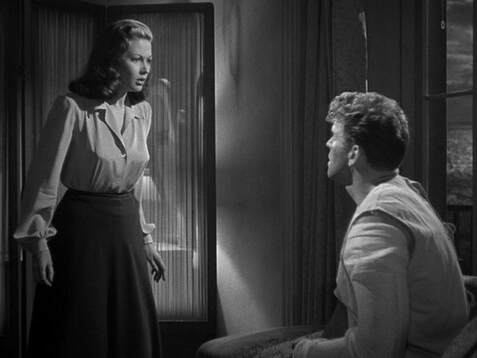
Their heist doesn't go as planned. There is a gun battle. Pop is killed and in retaliation Steve wounds Dundee and kills two of his me, but is himself seriously wounded. Steve is called a hero by the papers and his family buys it, but not Lt. Rodriquez. (Stephen McNally). He knows there had to be an inside man and Steve is it. He visits Steve in the hospital and tells him that if Anna double crossed him and she's with Slim then he's safe. Dundee will have no reason to risk getting back at him. But, if she double crossed Slim, then Slim will come after them and kill both. Steve doesn't want to hear it.
In The Killers, Swede, who is able to run and fight, lays on his bed calmly waiting for his fate. In Criss Cross, Steve lies in traction. He is scared witless and desperately wants to leave. He asks a man whose wife has been in a car accident to watch over him. The 'visitor' (Robert Osterich) is Dundee's man. Thompson, who has never been the brightest bulb in the pack, bribes him to drive to their hideout where Anna awaits. Once there
Anna explodes. She knows what's going to happen and wastes no time packing
Anna: "I have to pack. I have to hurry."
Steve: "You're going away? You're gonna leave me? Here?"
Anna: "How far could I get with you? What kind of a chance would we have? You can't move. You couldn't last a day!"
She's not done: 'Why did you have to come here in the first place? Why? Why? It was all working out. Everything was fine. Papers said you'd be in the hospital for weeks!" This is an interesting line. It could mean that she was fine being Dundee's girl before Steve returned home. It could also mean that because she wasn't expecting him for weeks it would have given her more than enough time to wait until Dundee got arrested, and then with the money leave to make a new life with or without Steve. There's no telling what Anna could do with over a hundred thousand dollars. There's nothing in her background to indicate she's reliable or loyal. She was dating Dundee until Steve came along, married Dundee the same day she had a date at the beach with Steve, and after four or five months of marriage took up with Thompson once again.
Anna is unique in the annals of femme fatales in that she brings about the demise of her two lovers at the same time. We can argue about who gets the gold medal, but Anna, along with Cathy Moffat and Kitty Collins belong on the Olympic podium of femme fatales.
From the moment he got off the bus and entered his old haunt everybody and his Uncle knew he came back to see her. Everybody and his other Uncle knew she was no good for him, but Steve wouldn't listen. I've seen some pretty hang dog looks, but it's hard to beat Steve 's when he realizes Anna played him for a chump. His last words to her are: "It could've been wonderful, but it didn't work out. What a pity it didn't work out." And that's how it is in the world of noir.
In The Killers, Swede, who is able to run and fight, lays on his bed calmly waiting for his fate. In Criss Cross, Steve lies in traction. He is scared witless and desperately wants to leave. He asks a man whose wife has been in a car accident to watch over him. The 'visitor' (Robert Osterich) is Dundee's man. Thompson, who has never been the brightest bulb in the pack, bribes him to drive to their hideout where Anna awaits. Once there
Anna explodes. She knows what's going to happen and wastes no time packing
Anna: "I have to pack. I have to hurry."
Steve: "You're going away? You're gonna leave me? Here?"
Anna: "How far could I get with you? What kind of a chance would we have? You can't move. You couldn't last a day!"
She's not done: 'Why did you have to come here in the first place? Why? Why? It was all working out. Everything was fine. Papers said you'd be in the hospital for weeks!" This is an interesting line. It could mean that she was fine being Dundee's girl before Steve returned home. It could also mean that because she wasn't expecting him for weeks it would have given her more than enough time to wait until Dundee got arrested, and then with the money leave to make a new life with or without Steve. There's no telling what Anna could do with over a hundred thousand dollars. There's nothing in her background to indicate she's reliable or loyal. She was dating Dundee until Steve came along, married Dundee the same day she had a date at the beach with Steve, and after four or five months of marriage took up with Thompson once again.
Anna is unique in the annals of femme fatales in that she brings about the demise of her two lovers at the same time. We can argue about who gets the gold medal, but Anna, along with Cathy Moffat and Kitty Collins belong on the Olympic podium of femme fatales.
From the moment he got off the bus and entered his old haunt everybody and his Uncle knew he came back to see her. Everybody and his other Uncle knew she was no good for him, but Steve wouldn't listen. I've seen some pretty hang dog looks, but it's hard to beat Steve 's when he realizes Anna played him for a chump. His last words to her are: "It could've been wonderful, but it didn't work out. What a pity it didn't work out." And that's how it is in the world of noir.
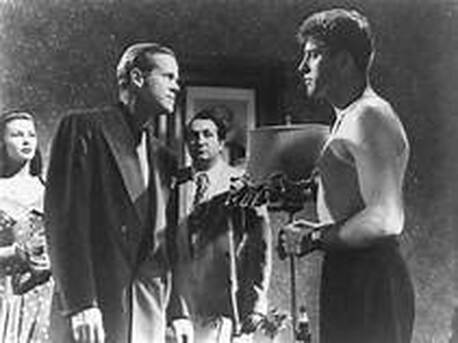
Criss Cross is a wonderfully directed movie, with great location shots, top notch acting and an ending as good as there is in film noir. The dialogue is for the most part, absent of wise-cracks or innuendos. It gets to the point much the same way the residents of Bunker Hill go about their lives. One of the joys of a good film noir or any film is to listen to the dialogue without watching the movie. For those who have seen the movie a couple of times try it out. The writer Daniel Fuchs of whom John Updike refers: "Nobody else writes like Daniel Fuchs. I think of him as a natural—a poet who never had to strain after a poetic effect, a magician who made magic look almost too easy." and
I feel the same way about Robert Siodmak and Criss Cross.
I feel the same way about Robert Siodmak and Criss Cross.
